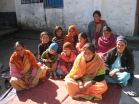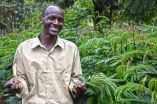(Press-News.org) URBANA, Ill. – Women in rural India who participate in a vocational training program learn more than just life skills. A recent University of Illinois study found that mothers who participated in a program designed to educate and empower women gained a network of peers that led to increased bargaining strength in the home, and significantly improved their children's consumption of rice and dairy.
"Prior to participating in Mahila Samakhya, which loosely translates to women of equal value, most of the participants reported regularly communicating with fewer than five women outside their families," said U of I economist Kathy Baylis. "Some of the women initially said things like, 'I never knew anybody like me could work outside of the home' and 'I never knew anyone like me could stand up to her husband.' But after participating in the program, even if they didn't go out and use that vocational training in jobs, they felt that they had a little more right to say, 'No, I think this is how we should be spending our money in our household.' Women were exerting more of a say over household resources," she said.
In India, over 40 percent of children under the age of five suffer from malnutrition. This is despite the fact that per capita income has more than doubled since the mid-1990s and agricultural production is at an all-time high, with large buffer stocks of cereals in government granaries.
"There's evidence that if women have more bargaining power in the household, particularly in developing countries where cash is very tight, quite often more resources go toward the kids," Baylis said. "So, to test that hypothesis, we went into homes with bowls and asked how many bowls this size of rice did your kids eat yesterday? Not only do we see evidence that more is going to kids, but more food is going to girls in particular, which is good because they tend to be the least powerful persons in the household. When times are tight, the girls' food is usually what's cut back," she said.
In the study, 487 women were surveyed from six of thirteen districts in Uttarakhand, four with the program and two without.
Baylis said that the study shows that women who are more empowered, educated, and mobile can actually change the village culture.
"Participants told us that before joining the program they couldn't work, had little contact outside the family, and had little say in the resources allocated to their children," Baylis said. "Their identity was always subsumed in their husband's, brother's, father's, or in-laws' identity. But after participating in Mahila Samakhya, women realized they have their own identity, that they can work if they want to, and that they can influence household and community decisions."
Baylis said that local men sometimes resist the program and prevent their wives from participating. As a result, initially only a few women may participate, but as others see the benefits, they muster up the courage to participate despite family opposition.
"In this area of India, domestic violence is a huge problem," Baylis said. "In a couple of the villages, we heard of support groups where women would go knock on doors and threaten to expose men if they didn't stop the violent behavior.
Baylis explained that the program is run through a branch of the Indian central government. A worker talks to people in the villages and gets a sense of where people might be receptive and finds out their interests, for example, if they'd like additional nutritional education or if there are particular job skills they would like to have.
"It's a very powerful program, but it is also very difficult to analyze because each program looks slightly different in each location. But the idea is the same – to bring together women in the village with some training and set up a support group," Baylis said.
This study is one of the first to study how peer networks affect female bargaining power and child welfare and one of the first evaluations of the Mahila Samakhya program since it began in 1995. The findings were shared with those who run the program to help them see what's working and what could be expanded.
INFORMATION:
"Expanding Horizons: Can Women's Support Groups Diversify Peer Networks in Rural India?" co-authored by Eeshani Kandpal, was published in the American Journal of Agricultural Economics. Funding was provided by the Arnold O. Beckman Award from the U of I Campus Research Board.
Malnourished children are better fed when mothers have network of peers
2014-03-10
ELSE PRESS RELEASES FROM THIS DATE:
New research shows elevated mercury from in-ground wastewater disposal
2014-03-10
As towns across Cape Cod struggle with problems stemming from septic systems, a recent study by a Woods Hole Oceanographic Institution (WHOI) scientist focuses on one specific toxic by-product: mercury. In a study of local groundwater, biogeochemist Carl Lamborg found microbial action on wastewater transforms it into more mobile, more toxic forms of the element.
His findings were published in Environmental Science and Technology in November 2013.
Mercury (Hg) is a toxic trace metal. Wastewater contains small amounts of it, but Lamborg found the chemical processes that ...
What's new in autism spectrum disorder? Harvard Review of Psychiatry presents research update
2014-03-10
Philadelphia, Pa. (March 10, 2014) – Recent years have seen exciting progress in key areas of research on autism spectrum disorders (ASD): from possible genetic causes, to effective treatments for common symptoms and clinical problems, to promoting success for young people with ASD entering college. Updates on these and other advances in ASD research are presented in the March special issue of Harvard Review of Psychiatry. The journal is published by Lippincott Williams & Wilkins, a part of Wolters Kluwer Health.
"Autism is one of the most challenging disorders to ...
Phosphorylation of tau protein in rats subjected to cerebral ischemia-reperfusion injury
2014-03-10
Transient brain ischemia has been shown to induce hyperphosphorylation of the microtu-bule-associated protein tau. To further determine the mechanisms underlying these processes, Dr, Bo Song and co-workers from School of Life Sciences, Tsinghua University in China found for the first time that the interaction of tau with glycogen synthase kinase (GSK)-3β and protein phosphatase 2A is altered during transient brain ischemia. In addition, the researchers found that the neuroprotective function of lithium chloride may depend partly on the altered phosphorylation of tau, ...
Pretreatment with SSTF prevents hippocampal neuronal apoptosis due to cerebral infarction
2014-03-10
Focal cerebral ischemia-reperfusion may lead to neuronal loss in the hippocampus, which is regarded as one of the basic pathological mechanisms underlying cognitive impairment. The neuronal apoptosis plays an important role in cerebral infarction, determining the number of loss of neurons and infarct volume. Growing evidence has suggested that Chinese herbs can inhibit hippocampal apoptosis caused by ischemia-reperfusion. Prof. Shumin Zhao and team from Chengde Medical College in China pretreated rats with scutellaria baicalensis stem-leaf total flavonoid (SSTF) intragastrically ...
Agroforestry can ensure food security and mitigate the effects of climate change in Africa
2014-03-10
Agroforestry can help to achieve climate change mitigation and adaptation while at the same time providing livelihoods for poor smallholder farmers in Africa.
Scientists at the World Agroforestry Centre (ICRAF) say agroforestry - which is an integrated land use management technique that incorporates trees and shrubs with crops and livestock on farms - could be a win-win solution to the seemingly difficult choice between reforestation and agricultural land use, because it increases the storage of carbon and may also enhance agricultural productivity.
In a special issue ...
Smokers' brains biased against negative images of smoking
2014-03-10
This news release is available in French. What if the use of a product influenced your perception of it, making you even more susceptible to its positive aspects and altering your understanding of its drawbacks? This is precisely what happens with cigarettes in chronic smokers, according to a recent study by the Institut universitaire en santé mentale de Montréal and Université de Montréal.
The study showed that chronic smokers have altered emotional reactions when they are exposed to negative and positive images associated with tobacco. "We observed a bias depending ...
All paths lead to Rome, even the path to condensed matter theory
2014-03-10
Italian physicist Carlo Di Castro, professor emeritus at the University of Rome Sapienza, Italy, shares his recollections of how theoretical condensed matter physics developed in Rome, starting in the 1960s. Luisa Bonolis, a researcher at the Max Planck Institute for the History of Science in Berlin, Germany, invited Di Castro to reflect upon his research career, which he did in an interview published in EPJ H.
In this unique document, Di Castro talks about his upbringing during the second World War. He also explains how this childhood experience later influenced his ...
Two-dimensional material shows promise for optoelectronics
2014-03-10
A team of MIT researchers has used a novel material that's just a few atoms thick to create devices that can harness or emit light. This proof-of-concept could lead to ultrathin, lightweight, and flexible photovoltaic cells, light emitting diodes (LEDs), and other optoelectronic devices, they say.
Their report is one of three papers by different groups describing similar results with this material, published in the March 9 issue of Nature Nanotechnology. The MIT research was carried out by Pablo Jarillo-Herrero, the Mitsui Career Development Associate Professor of Physics, ...
Doctors often uncertain in ordering, interpreting lab tests
2014-03-10
A survey of primary care physicians suggests they often face uncertainty in ordering and interpreting clinical laboratory tests, and would welcome better electronic clinical decision support tools.
The results of the survey, sponsored by the U.S. Centers for Disease Control and Prevention, were published in the March-April issue of The Journal of the American Board of Family Medicine.
"The optimal testing pathways to arrive at correct diagnoses is changing, so it is difficult for primary care physicians to keep up with new and efficient testing algorithms," says Dr. John ...
Study finds pill may represent promising treatment for stubborn blood cancers
2014-03-10
(WASHINGTON, March 10, 2014) – A pill that suppresses a key regulator of cancer growth may provide hope to relapsed leukemia and lymphoma patients running out of treatment options for their aggressive, treatment-resistant disease, according to three reports* published online today in Blood, the journal of the American Society of Hematology.
Patients with blood cancer are typically administered a combination of chemotherapy and immunotherapy, the latter using the body's own immune system to help fight disease, as a first line of treatment. While chemotherapy has traditionally ...


